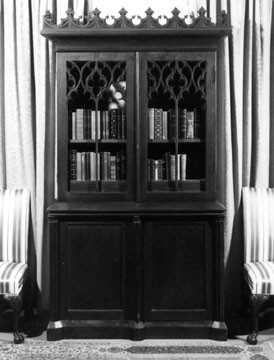A Collector’s Collection:The Rosenbach Museum & Library

Herman Melville's American Gothic-style bookcase containing his personal collection of first-edition literary classics.
Through Philip’s interest in fine and decorative arts and A.S.W.’s in rare books and manuscripts, the brothers created their own success. In 1925 they bought their home at 2006 DeLancey Place – Philip and A.S.W. Rosenbach had arrived and their new address was proof. Their business was growing quickly, and their reputations along with it. Philip and A.S.W. owned shops in New York and Philadelphia and had clients named Widener, Folger, and Huntington. In 1949 they purchased their second home on DeLancey at number 2010….This was the brothers’ last home – A.S.W. died in 1952 and Philip in 1953.
The Art of Daily Life on DeLancey Place
The lives of the Rosenbach brothers straddled the nineteenth and twentieth centuries and reflected the associated social and economic changes. Influential works like The Decoration of Houses by Edith Wharton and Ogden Codman, Jr. (published in 1897, coincidentally the year that Philip Rosenbach began his furniture business) instructed the upper class in the relationship of architecture and décor to proper behavior and hygiene. Economist Thorstein Veblen’s Theory of the Leisure Class (1899) gave the designation “conspicuous consumption” to the accumulation of material wealth as the modern expression of power, success, and social honor. When Philip and A.S.W. began The Rosenbach Company in 1903, selling decorative arts, books, and manuscripts, the customers they sought were the very people Wharton, Codman, and Veblen addressed.
The display of material wealth mattered in a mannered society. J.P. Morgan, who along with his son would become a Rosenbach customer in 1930, made the pages of the New York Herald in 1889 for his receipt of a three-hundred piece, $50,000 dessert service made by Tiffany & Co…..In the late nineteenth century manufacturers of luxury goods began issuing catalogues that listed appropriate gifts for ladies and gentlemen. Among these gifts were the types of objects the Rosenbachs began to accumulate after their move to DeLancey Place. For the Rosenbachs, having an elegant residence filled with fine objects not only signaled their economic arrival, but was intertwined with their work. They both sold and lived with fine objects; they sought wealthy clients and may have needed to emulate them materially to attain them professionally.